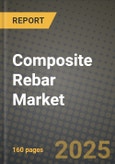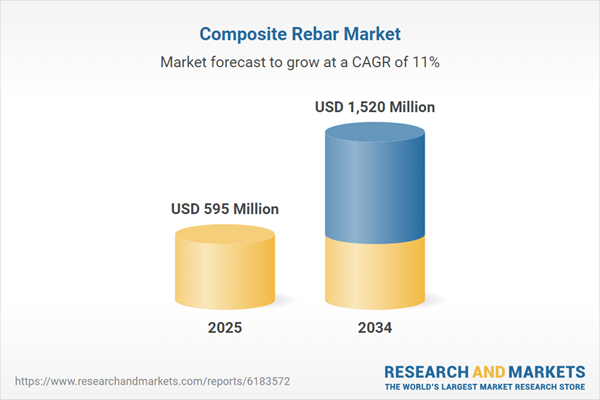Composite Rebar Market
The composite rebar market covers fiber-reinforced polymer (FRP) reinforcement manufactured primarily by pultrusion using glass (GFRP), basalt (BFRP), carbon (CFRP), or hybrid fibers in vinyl ester/epoxy matrices, with surface treatments (sand-coated, helically wrapped) for bond. It addresses corrosion-prone and specialty applications where steel’s mass, magnetism, or corrosion risk are constraints. Core end-uses include marine and coastal structures (quay walls, decks), bridges and decks, water/wastewater facilities, chemical plants, tunnel linings, pavements and slabs-on-grade, retaining walls, mining, power/T&D foundations, and healthcare/MRI rooms requiring non-magnetic reinforcement. Trends emphasize lifecycle cost optimization against chloride attack, growing inclusion of FRP in national design codes and agency specifications, BIM object libraries and design plug-ins, and prefabricated elements (cages, meshes, stirrups) that cut site time. Advances in pultrusion speed, hybrid fabrics, thermoplastic matrices for recyclability, and headed/anchorage solutions improve constructability. Drivers include corrosion durability eliminating cathodic protection, lower logistics costs via lightweight bars, non-conductive/non-magnetic properties, and sustainability targets from public owners. The competitive landscape spans specialized pultruders, integrated FRP construction brands, resin and fiber suppliers, and regional fabricators with bending/assembly capability; rental and distribution partners influence spec adoption. Differentiation rests on certified bond and tensile properties, creep-rupture performance, fire/thermal behavior with cover detailing, bend/form offerings (factory-bent vs. straight), QA traceability, and field engineering support. Key challenges are fragmented code acceptance across jurisdictions, engineer familiarity and training needs, elevated-temperature design and fireproofing details, anchorage/lap-splice practices, and raw-material price volatility. Vendors coupling code-compliant data, constructible detailing, and robust project support are best positioned as owners shift to durable, low-maintenance infrastructure.Composite Rebar Market Key Insights
- Corrosion economics drive specification
- Codes and standards cross the tipping point
- GFRP holds volume; CFRP is niche performance
- Constructability improves with prefabrication
- Bond and surface engineering matter
- Creep-rupture and fatigue data underpin design
- Thermal/fire design is a known hurdle
- Electromagnetic neutrality opens niches
- Digital engineering accelerates adoption
- Supply chain and QA decide repeat awards
Composite Rebar Market Reginal Analysis
North America
DOT acceptance and standard details expand FRP in bridge decks, barriers, and coastal works. Municipal water/wastewater and slab-on-ground projects adopt GFRP for corrosion and non-conductivity. Competitive bids hinge on certified properties, factory-bent components, and on-site training; rental distributors influence reach.Europe
Durability mandates and whole-life-carbon assessments support FRP in marine and chemical environments. Tunnel and rail platforms trial non-magnetic reinforcement to reduce stray-current issues. Public procurement values EPDs, recyclability roadmaps, and harmonized design documentation; local fabrication for meshes/stirrups shortens schedules.Asia-Pacific
Coastal megaprojects, desalination, and ports spur FRP demand, with value-engineered GFRP leading. Japan/Australia emphasize rigorous test data and QA; Southeast Asia prioritizes corrosion resilience and logistics gains. Precast yards integrate FRP cages for rapid urban works; government specs evolve via pilot bridges.Middle East & Africa
High salinity, heat, and spray exposure make FRP compelling for seawalls, piliings, and utility foundations. Owners seek proven high-temperature detailing and UV stability; sand-coated bars and colored IDs aid inspection. Turnkey packages - design assist, prefab cages, and site supervision - are favored in fast-track builds.South & Central America
Ports and coastal highways adopt GFRP to cut maintenance under budget constraints. Water plants and mining structures use FRP to avoid chemical attack. Currency volatility increases interest in local pultrusion/finishing partners; training for inspectors and clear QC submittals accelerate acceptance.Composite Rebar Market Segmentation
By Product
- GFRP Rebar
- CFRP Rebar
- BFRP Rebar
By Application
- Highways
- Bridges & Buildings
- Marine Structures & Waterfronts
- Water Treatment Plants
- Others
Key Market players
Owens Corning, Pultrall Inc., Mateenbar Limited, Dextra Group, Neuvokas Corporation, Schöck Bauteile GmbH, BP Composites Inc., Kodiak Structural Composites, Sireg Geotech S.r.l., FiReP Group, SFTec Inc., Technobasalt-Invest LLC, Magmatech Ltd., Galen LLC, ArmastekComposite Rebar Market Analytics
The report employs rigorous tools, including Porter’s Five Forces, value chain mapping, and scenario-based modelling, to assess supply-demand dynamics. Cross-sector influences from parent, derived, and substitute markets are evaluated to identify risks and opportunities. Trade and pricing analytics provide an up-to-date view of international flows, including leading exporters, importers, and regional price trends.Macroeconomic indicators, policy frameworks such as carbon pricing and energy security strategies, and evolving consumer behaviour are considered in forecasting scenarios. Recent deal flows, partnerships, and technology innovations are incorporated to assess their impact on future market performance.
Composite Rebar Market Competitive Intelligence
The competitive landscape is mapped through proprietary frameworks, profiling leading companies with details on business models, product portfolios, financial performance, and strategic initiatives. Key developments such as mergers & acquisitions, technology collaborations, investment inflows, and regional expansions are analyzed for their competitive impact. The report also identifies emerging players and innovative startups contributing to market disruption.Regional insights highlight the most promising investment destinations, regulatory landscapes, and evolving partnerships across energy and industrial corridors.
Countries Covered
- North America - Composite Rebar market data and outlook to 2034
- United States
- Canada
- Mexico
- Europe - Composite Rebar market data and outlook to 2034
- Germany
- United Kingdom
- France
- Italy
- Spain
- BeNeLux
- Russia
- Sweden
- Asia-Pacific - Composite Rebar market data and outlook to 2034
- China
- Japan
- India
- South Korea
- Australia
- Indonesia
- Malaysia
- Vietnam
- Middle East and Africa - Composite Rebar market data and outlook to 2034
- Saudi Arabia
- South Africa
- Iran
- UAE
- Egypt
- South and Central America - Composite Rebar market data and outlook to 2034
- Brazil
- Argentina
- Chile
- Peru
Research Methodology
This study combines primary inputs from industry experts across the Composite Rebar value chain with secondary data from associations, government publications, trade databases, and company disclosures. Proprietary modeling techniques, including data triangulation, statistical correlation, and scenario planning, are applied to deliver reliable market sizing and forecasting.Key Questions Addressed
- What is the current and forecast market size of the Composite Rebar industry at global, regional, and country levels?
- Which types, applications, and technologies present the highest growth potential?
- How are supply chains adapting to geopolitical and economic shocks?
- What role do policy frameworks, trade flows, and sustainability targets play in shaping demand?
- Who are the leading players, and how are their strategies evolving in the face of global uncertainty?
- Which regional “hotspots” and customer segments will outpace the market, and what go-to-market and partnership models best support entry and expansion?
- Where are the most investable opportunities - across technology roadmaps, sustainability-linked innovation, and M&A - and what is the best segment to invest over the next 3-5 years?
Your Key Takeaways from the Composite Rebar Market Report
- Global Composite Rebar market size and growth projections (CAGR), 2024-2034
- Impact of Russia-Ukraine, Israel-Palestine, and Hamas conflicts on Composite Rebar trade, costs, and supply chains
- Composite Rebar market size, share, and outlook across 5 regions and 27 countries, 2023-2034
- Composite Rebar market size, CAGR, and market share of key products, applications, and end-user verticals, 2023-2034
- Short- and long-term Composite Rebar market trends, drivers, restraints, and opportunities
- Porter’s Five Forces analysis, technological developments, and Composite Rebar supply chain analysis
- Composite Rebar trade analysis, Composite Rebar market price analysis, and Composite Rebar supply/demand dynamics
- Profiles of 5 leading companies - overview, key strategies, financials, and products
- Latest Composite Rebar market news and developments
Additional Support
With the purchase of this report, you will receive:- An updated PDF report and an MS Excel data workbook containing all market tables and figures for easy analysis.
- 7-day post-sale analyst support for clarifications and in-scope supplementary data, ensuring the deliverable aligns precisely with your requirements.
- Complimentary report update to incorporate the latest available data and the impact of recent market developments.
This product will be delivered within 1-3 business days.
Table of Contents
Companies Mentioned
- Owens Corning
- Pultrall Inc.
- Mateenbar Limited
- Dextra Group
- Neuvokas Corporation
- Schöck Bauteile GmbH
- BP Composites Inc.
- Kodiak Structural Composites
- Sireg Geotech S.r.l.
- FiReP Group
- SFTec Inc.
- Technobasalt-Invest LLC
- Magmatech Ltd.
- Galen LLC
- Armastek
Table Information
| Report Attribute | Details |
|---|---|
| No. of Pages | 160 |
| Published | November 2025 |
| Forecast Period | 2025 - 2034 |
| Estimated Market Value ( USD | $ 595 Million |
| Forecasted Market Value ( USD | $ 1520 Million |
| Compound Annual Growth Rate | 11.0% |
| Regions Covered | Global |
| No. of Companies Mentioned | 15 |









